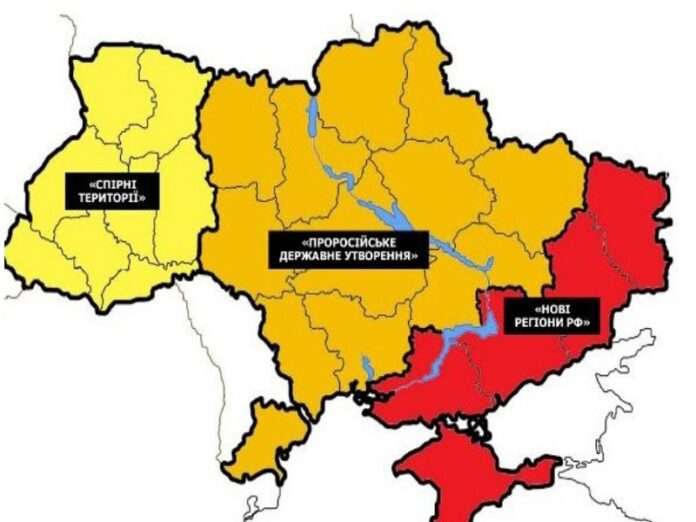Interfax-Ukraine cited their country’s Intelligence Community last week to report that Russia allegedly plans to trifurcate their country by 2045 and is preparing to share its proposal with Trump. The first part would include the full incorporation of the four Ukrainian regions that joined Russia in September 2022; the second would stretch up to the former Polish and Romanian borders, host Russian troops, and be Russian-friendly; while the third would be “disputed” between Ukraine’s neighbors.
It’s extremely unlikely that Trump would agree to such a scenario or that Russia will be able to impose it upon Ukraine against the US’ will. The reason is that it’s still struggling to obtain full control over a single Ukrainian region due to the military-strategic dynamics of the conflict after its improvised evolution into a “war of attrition” following the failure of spring 2022’s peace talks. There’s also no incentive for Trump to coerce Ukraine into a complete surrender that would move Russian troops closer to NATO’s borders.
On top of that, Russia would likely also struggle to quell the explosion of unconventional warfare that could likely follow its entrance into what Ukrainians consider to be the heartland of their ethnic nation, and it’s possible that this could turn into a quagmire that ultimately doesn’t justify the costs. After all, the initial phase of the special operation aimed to coerce Ukraine into agreeing to demilitarization and denazification, after which the national authorities would be tasked with implementing these policies.
Russia never planned to indefinitely deploy troops to the country for these purposes precisely because it feared the potential long-term consequences of its strength being sapped through the unconventional warfare campaign that might follow. Even in the event that Russia decided to take these risks and was able to militarily advance that far across the Dnieper, NATO could conventionally intervene to stop it at the river and freeze the new Line of Contact (LOC) after a Cuban-like brinksmanship crisis.
Another point is that none of Ukraine’s western neighbors have territorial claims to its peripheral regions that used to be part of their own countries before World War II. They’re now almost entirely populated by ethnic Ukrainians, who none of them want to become economically and politically responsible for either. Ethnic cleansing and genocide are off the table since they’re not going to risk the reputational consequences nor the possibility of an unconventional war breaking out as a result of these efforts.
Accordingly, Ukraine’s Intelligence Community was either duped by an obvious fake that they fell for due to the panic and paranoia that’s taking hold of them after Trump’s historic electoral victory, or they simply made it up and laundered this false report through the media in order to elicit a reaction. Regarding the second scenario, the purpose might have been to pressure Trump’s team into clarifying exactly what they have in mind, whether it’s “escalating to de-escalate” or a straight deal with Russia.
Whatever the truth behind Interfax-Ukraine’s report may be, there’s almost no chance that their country will be trifurcated, with the most likely scenario being that the conflict freezes somewhere along the LOC (with some adjustments) and a demilitarized zone (DMZ) is imposed. If there’s any trifurcation scenario that might unfold, it’s that Russia militarily coerces Ukraine and/or diplomatically convinces Trump into agreeing to a massive DMZ north of the LOC and east of the Dnieper, which was discussed here in March.
That would be a herculean feat for Russia to pull off, but it would represent the best possible compromise for all parties. Russia’s security would be ensured through the withdrawal of all heavy equipment east of the Dnieper while Ukraine would retain sovereignty within this massive DMZ. Ukraine would be deterred from breaking the ceasefire due to the DMZ while Russia would be deterred by the “security guarantees” that Ukraine clinched with a bunch of NATO countries throughout this year.
While Russia could storm into northeastern Ukraine’s DMZ in that event, NATO could also storm into western Ukraine and possibly even cross the Dnieper if it’s swift enough to impose a new LOC through the earlier mentioned Cuban-like brinksmanship scenario, which might be inevitable with time. No matter what, however, it’s extremely unlikely that a Russian-friendly Central Ukrainian State will form, which hosts Russian forces and abuts territories that are “disputed” with NATO’s eastern members.
That political fantasy might have been believable in the early months of the conflict, but no serious observer lent credence to it after Russia’s pullbacks from Kharkov and Kherson Regions at the end of 2022. As was already explained, even if Russia achieves a game-changing military breakthrough before Trump might have time to “escalate to de-escalate” like was written about here, here, and here, NATO could conventionally intervene to impose a new LOC under brinksmanship conditions if it has the will.
For these reasons, nobody should take Interfax-Ukraine’s report seriously. It’s either an obvious fake that they were duped into reporting on, perhaps as part of a psychological operation by Russia’s own Intelligence Community in order to make the global public think that there’s still a chance that it can achieve its maximum goals despite the current odds, or was laundered by Ukraine’s Intelligence Community in order to elicit a reaction. In any case, nothing will likely come of this political fantasy.







